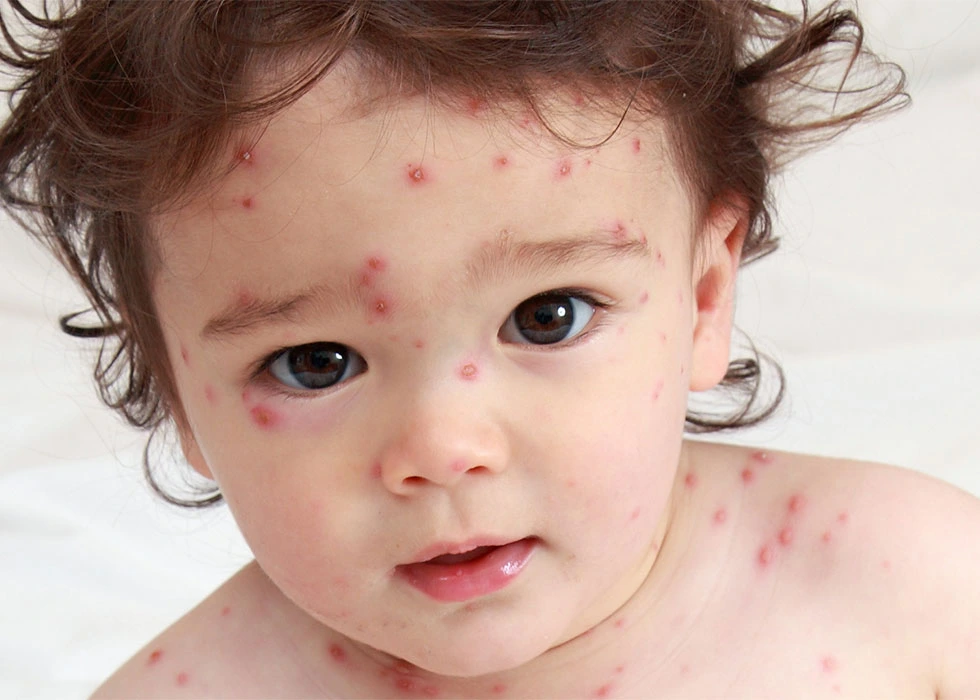
Chickenpox (Varicella): Symptoms, Causes, Complications & Prevention
- August 23, 2025
- 1 Like
- 19 Views
- 0 Comments
Overview
Chickenpox, also known as varicella, is a highly contagious viral infection caused by the varicella-zoster virus. It produces an extremely itchy, blister-like rash that progresses through three stages: red bumps (papules), fluid-filled blisters (vesicles), and scabs.
Before the chickenpox vaccine became available in the mid-1990s, nearly everyone contracted the disease in childhood. Today, cases have declined by more than 90% thanks to vaccination. While chickenpox is generally mild in children, it can be serious in adults, pregnant women, newborns, and people with weakened immune systems.
The best protection is the chickenpox (varicella) vaccine, which is over 90% effective at preventing infection.
Causes & Transmission
Chickenpox is caused by the varicella-zoster virus (VZV). It spreads easily through:
- Direct contact with the rash or fluid from blisters.
- Airborne droplets from coughs or sneezes.
- Touching contaminated surfaces and then touching your mouth, eyes, or nose.
A person is contagious from 1–2 days before the rash appears until all blisters have crusted over (about 7–10 days).
Symptoms of Chickenpox
Symptoms usually appear 10–21 days after exposure and develop in stages:
- Early symptoms (1–2 days before rash):
- Fever (often mild to moderate)
- Headache
- Fatigue
- Loss of appetite
- Stomachache or general discomfort
- The rash:
- Starts on the face, chest, or back, then spreads across the body.
- Appears in waves for several days.
- Progresses through three stages:
- Papules: Raised red bumps.
- Vesicles: Fluid-filled blisters that break and leak.
- Scabs: Crusts that form as blisters heal.
- A person may have bumps, blisters, and scabs all at once.
The rash usually lasts 5–10 days. Children often recover fully, but adults may have more severe cases.
Risk Factors
You are at greater risk of chickenpox if you:
- Have never had chickenpox and are not vaccinated.
- Work in schools, daycare centers, or healthcare settings.
- Live with children or unvaccinated people.
- Have a weakened immune system due to cancer, HIV, or immunosuppressive medications.
- Are pregnant and unvaccinated.
Complications
While often mild, chickenpox can lead to serious health issues, especially in adults, infants, and immunocompromised people. Possible complications include:
- Bacterial infections of the skin, blood, or soft tissues.
- Pneumonia.
- Encephalitis (swelling of the brain).
- Reye’s syndrome (a rare but life-threatening brain and liver condition in children/teens who take aspirin).
- Dehydration.
- Toxic shock syndrome (rare).
- Pregnancy risks: Miscarriage, low birth weight, or congenital defects if infection occurs early in pregnancy.
- Newborn infection: If a mother develops chickenpox just before or after delivery, the newborn may face life-threatening illness.
Chickenpox and Shingles Connection
After recovery, the varicella-zoster virus stays dormant in nerve cells. Years later, it can reactivate as shingles (herpes zoster), a painful blistering rash.
- Shingles risk increases with age or a weakened immune system.
- People with shingles can spread chickenpox (but not shingles itself) to those who have never had chickenpox or the vaccine.
- The shingles vaccine (Shingrix) is recommended for adults over 50, and for immunocompromised adults over 19.
Diagnosis
Chickenpox is usually diagnosed by physical exam, based on the rash and symptoms.
If uncertain, tests may include:
- Blood tests for varicella antibodies.
- Swabs from throat, nose, or blisters.
Treatment & Home Care
There is no cure for chickenpox — the infection must run its course (7–14 days). Treatment focuses on easing symptoms and preventing complications.
At-home remedies:
- Rest and fluids to prevent dehydration.
- Cool baths (with oatmeal or baking soda) and calamine lotion for itching.
- Over-the-counter antihistamines (e.g., diphenhydramine) for itching.
- Trim nails and use mittens on young children to prevent scratching.
- Soft, bland foods if mouth blisters are present.
Medications:
- Acetaminophen (Tylenol) for fever and pain.
- Avoid aspirin (risk of Reye’s syndrome) and ibuprofen in children (linked to skin infections).
- Antiviral drugs (acyclovir) may be prescribed for adults, immunocompromised patients, or severe cases if started within 24 hours of rash onset.
- Immune globulin (VZIG) may be given after exposure to high-risk individuals (e.g., newborns, pregnant women, immunocompromised).
Prevention
The chickenpox vaccine is the safest and most effective way to prevent infection.
- Children should get two doses:
- 1st dose: 12–15 months old.
- 2nd dose: 4–6 years old.
- Older children, teens, and adults who haven’t had chickenpox or the vaccine should also get two doses at least 28 days apart.
- The vaccine is over 90% effective and reduces severity even if infection occurs.
- Combination vaccines: MMRV (measles, mumps, rubella, varicella) for children, or standalone varicella vaccine (Varivax).
Who should not get the vaccine?
- Pregnant women.
- People with severe immune disorders, cancer, or certain allergies.
- Those who recently had blood transfusions or other live vaccines.
Takeaways
- Chickenpox is highly contagious but usually mild in children.
- Adults, pregnant women, newborns, and immunocompromised people face greater risk of complications.
- The chickenpox vaccine provides long-term protection and is part of routine immunization schedules.
- People who had chickenpox are at risk of shingles later in life, but shingles vaccination can prevent this.


Leave Your Comment